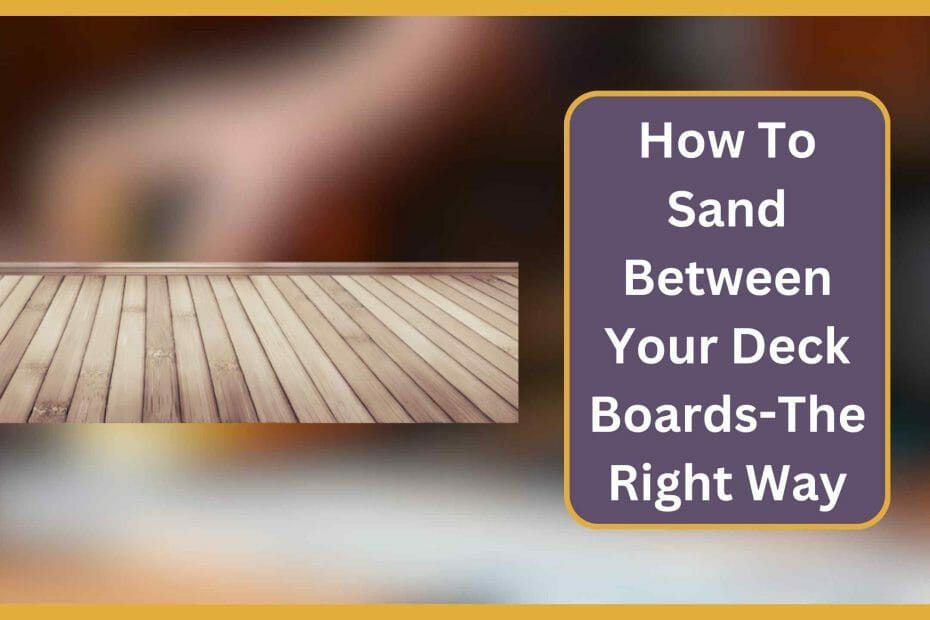How To Sand Between Your Deck Boards? Have you noticed that your deck rails are looking dull and dingy? Or maybe the wood between the boards of your deck has become rough with years of weathering? You might be able to fix this yourself by sanding between the deck boards with the right tools and technique.
Before you start, make sure you have the suitable materials and know what to do once you’re done to avoid further damage to your deck. These instructions will teach you how to sand between deck boards in different ways to find one that works best for your situation. You can also Sand your Deck with a Floor sander.
Do You Want To Know How To Sand Between Your Deck Boards?
When sanding between deck boards, you’re stripping off any coatings, sealants, or paint applied to them. This step is essential if you have new wood and need to apply a fresh protective finish. If your deck has been exposed to rot or damage and needs repair, it’s also necessary.
Sanding between deck boards can be completed with a power sander or manually using sandpaper. Before starting, wear all of your safety gear: safety glasses, hearing protection, dust mask, and work gloves (at least on your hands). When done correctly, sanding between deck boards can help make sure all surfaces are smooth for a new finish.
Tools and materials
- Sandpaper
- Grits
- Sealant
- Sander
- Safety Gear: Safety glasses, hearing protection, dust mask, and work gloves (at least on your hands)
Best grit for sanding between your deck boards

- Here’s one way to sand the deck railing. You’ll need 80 grit, a belt sander, and a respirator for safety. First, use 80-grit sandpaper on your belt sander and smooth out areas where splinters or rough sections aren’t safe for bare feet. Once you have those down, sand down another few inches below that level to make your boards all smooth. If you find any nails sticking up, get them flush with the wood before continuing with sanding.
- After everything is smooth and flat, move on to 150-grit sandpaper to finish any sharp edges or rough spots left behind by previous steps.
- If everything looks good at 150 grit, switch to 220-grit paper to make sure every inch of your deck is silky smooth.
- If it still needs more work after 220-grit paper, go back up in grit until it’s just right—but be careful not to go too far because then it will start tearing into the wood instead of smoothing it out.
Things To Consider Before You Start Sand Your Deck Boards
Make sure you wear eye protection and a mask; protect your lungs from dust with a respirator. The idea is to remove any loose paint, dirt, or other materials from between each plank of wood so that you can adequately caulk and paint it.
- When using an electric sander, start with a coarser grit paper and then move down to finer grits; don’t skip over areas just because they’re already smooth (you want them all smooth!).
- Start with 150-grit sandpaper on your block sander or whatever else you’re using when sanding by hand. Then go up to 220, 320, and finally 400-grit sandpaper before moving onto a tack cloth.
- If you have time, wait until after painting to do the final sanding—it will be easier than now. Also, remember that there are many different deck boards out there.
- Some may need staining before sealing; others may require more prep work before painting or sealing.
- Always check manufacturer instructions for details about what type of preparation is required for your specific type of deck board!
Steps for Successful Sanding
While it’s tempting to take a saw and hack away at your deck boards, there is a better way. Making sure you sand between deck boards effectively will ensure you don’t damage your wood and get it smooth enough for painting or sealing. By following these steps, you can successfully sand between deck boards in just a few hours:
- Remove all nails and screws with a pry bar or crowbar. In some cases, boards are attached with glue; if so, use an angle grinder fitted with a flapper disc designed for drilling concrete or brick.
- Sweep up any debris left behind by removing nails and screws.
- Vacuum dust from between each board using a hose attachment on your vacuum cleaner.
- Use a belt sander equipped with 80-grit paper to remove loose paint and other surface coatings from each board.
- Use a circular sander equipped with 100-grit paper to remove any remaining loose paint, rust, or other surface coatings from each board.
- Use 220-grit sandpaper on a circular sander to remove dirt and minor defects such as dents on each board.
- Use 320-grit sandpaper on a circular sander to remove significant defects such as dents on each board.
- Use 400-grit sandpaper on a circular sander to remove deep scratches on each board.
- Apply one layer of sealant to each board using a roller applicator.
- Apply two layers of sealant to each board using a roller applicator.
- Allow the sealant to dry according to the manufacturer’s instructions before continuing with any additional finishing steps such as staining or painting.
Final Touch, Stain Your Deck
Once you’ve sanded your deck and wiped it down, it’s time to stain it. Wood is porous, so applying a stain that seeps into and dries quickly. The trick is not over-or under-doing it you want even coverage with no scars or missed spots. Go with a water-based stain; oil stains are toxic and require ventilation during the application, which can be messy if they drip onto patio stones, etc.
Water-based stains also dry faster, meaning less chance of staining surrounding surfaces. Apply using a foam brush in long strokes from left to right (or vice versa) to cover all areas evenly. For extra protection against spills and wear, apply two coats of stain. If you don’t have experience painting or staining wood, hire someone who does it’ll make for much better results than attempting it yourself!
Best Way To Sand a Painted Deck.
Sanding is laborious if you have a painted deck because paint splinters easily and can dull your sandpaper. Instead of using medium-grit paper, work with fine-grit instead; it will preserve the finish and make your job much easier.
A sanding sponge is a great way to remove old paint quickly without removing too much wood if you’re doing touch-ups.
Don’t make your project bigger than it needs to be by over-sanding.
When you’re doing a big project like stripping and refinishing a deck, the temptation is always there. You want to ensure that your finished product is perfect, so you want to make sure every board and corner looks right. The downside? By over-sanding areas of your deck, such as between boards and on steps, you can cause more damage than good.
All it takes is one tiny piece of debris hidden between cracks or crevices in your deck boards for grit or sawdust to become trapped. To prevent yourself from making costly mistakes with sanding and refinishing projects, always work slowly and carefully; you’ll be able to easily touch up any trouble spots after your finished coat has dried anyway!
3 Benefits of sanding your deck boards

There are many benefits to sanding your deck boards.
- First, the deck boards will be smooth enough for painters and sealers to apply a finish that won’t pick up dirt or mud.
- Second, the paint or sealer will stick to the newly-smooth surface.
- Third, you will be able to add a coat of paint or sealant without worrying about any heavy-duty scraping and sanding, which can damage your deck boards over time.
Frequently Asked Questions
Here are some questions which people frequently ask about sand between deck boards or deck railings:
How to remove paint from wood?
To take off old paint from wood using a shop vac, follow these steps:
- Attach the hose to the shop vacuum
- Attach the hose to the vacuum and turn on the vacuum
- Attach vac to wood and start vacuuming
- Go across the wood until you get rid of the old paint
- Repeat step 3 for another side
How to sand under the deck railing?
You will need some rubber-covered board to sand under a deck railing (like a shop vac). You will also need to attach the hose to your shop vac and set the vacuum on the deck railing. You don’t want any of the wood underneath to get damaged when you sand it. So, make sure you go across the railings as evenly as possible with your vacuum.
What Finish Should I Use on My Deck?
Many deck owners choose to paint their decks. If you choose to paint your deck, you’ll need to consider the type of finish you choose for your deck. For example, polyurethane (PU) paint will provide a more durable finish than varnish or oil-based paint.
Can I Stain My Deck on My Own?
Yes. Many people choose to do this themselves, but it’s essential to know that there are certain things you can’t do when staining your deck on your own. For example, if you’re staining a deck with an oil-based stain, don’t apply the first coat until the previous stain has completely dried. You should also avoid applying any sealant over your newly stained deck because this can cause cracking and peeling over time.
What is the best way to sand between deck boards?
The best way to sand between deck boards is to use a narrow sanding tool or a sanding sponge. Insert the tool or sponge between the boards and move it back and forth to sand the surface evenly. Alternatively, you can use a pressure washer or a deck cleaning solution to remove dirt and grime from between the boards.
How do I make space between deck boards?
To make space between deck boards, you can use a deck board spacing tool or a chisel. Place the tool or chisel between the boards and gently tap it to create a gap. Ensure that the gap is uniform for proper ventilation and drainage.
What is the fastest way to sand a deck?
The fastest way to sand a deck is to use a floor drum sander or a belt sander with coarse-grit sandpaper. These power tools can cover larger areas quickly. However, caution should be exercised to avoid over-sanding or damaging the wood surface. It’s recommended to use them in conjunction with other sanding tools for a more comprehensive result.
How do you clean between wood deck planks?
To clean between wood deck planks, you can use a deck cleaner solution or a mixture of mild detergent and water. Apply the solution to the gaps between the planks and scrub with a stiff brush or a deck cleaning tool. Rinse thoroughly with water afterward to remove any residue. Additionally, a pressure washer can be used to remove stubborn dirt or debris from between the planks.
Conclusion
You now know how to sand between deck boards and steps. If you’re looking for a way to make your house look better while also adding value, consider having your deck repaired. Some homeowners go so far as hiring a contractor just for such projects, but if you have some free time, you can save money by taking care of it yourself with elbow grease and some sandpaper. Now that you know how simple it is to sand between deck boards and steps take care of that splintering problem before fall arrives!

Why Trust About Sanders?
When it comes to the world of sanding and sanders, you need a trusted source of information and guidance to ensure you achieve those perfect finishes. That's where I come in – I'm Martin, a dedicated sanding enthusiast with a relentless passion for attaining flawless surfaces. With years of hands-on experience in the sanding industry, I've honed my skills and expertise to provide you with the most reliable and accurate insights. What sets me apart is my commitment to excellence. I meticulously handpick each sander after rigorous testing, ensuring that only the best tools make it to your hands. My goal is to empower you with the knowledge and recommendations you need to tackle any sanding task confidently. When you trust About Sanders, you're putting your faith in a seasoned expert who shares your passion for perfection and strives to deliver top-notch information and reviews for every sanding challenge.
